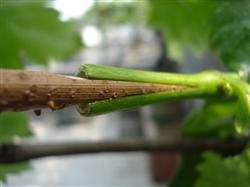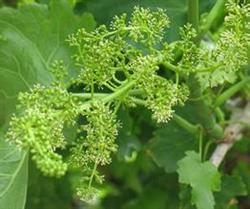A new method of grape green branch grafting

Grape green branch grafting is a good way to quickly raise seedlings and renew old trees. The grafting time is in the idle season after summer sowing. With lignified green branches, the survival rate of grafting can reach more than 95%. Each person can receive 500 to 800 seedlings per day. After that, the new branches can be lignified before autumn, can survive the winter safely, the interface heals well, and the seedling quality is high. The main technical points of the new method of green branch grafting are as follows: grafting with petiole is changed to grafting without petiole, which has the advantages of strict bandage, impermeability and high survival rate. The grafted leaf buds were changed into grafted winter buds, the winter buds were fat and strong, and the new branches germinated after grafting were sturdy and all lignified before autumn. After that, wrap the scion with a thin plastic strip, so that it is impervious to air and water, so as to facilitate survival, and fasten the interface of the rootstock with thick strips to facilitate healing. The specific operation methods are as follows: first, the rootstock uses 2-year-old or 1-year-old Jufeng seedlings with developed roots and strong growth as rootstocks, border planting, row spacing of 50 to 60 cm, plant spacing of 30 to 40 cm. Watering after planting, flat stubble in time (leaving two full buds at the lower end of each seedling). After germination, each seedling leaves only one strong bud to grow upward, erase the tillering bud, and make the seedling sturdy when it grows seven or eight leaves. Second, the scion selected excellent varieties, disease-free, moderate thickness of robust branches as scions, used as scion branches and secondary shoots removed 20 to 30 days before grafting. Third, the grafting time is generally from the end of May to June, preferring early to late, watering the nursery two or three days before grafting. Grafted after 9: 00 a. M. on a sunny day, the knife uses a single-edged razor, and the thickness of the rootstock seedling is roughly the same as that of the scion branch, which is semi-lignified, that is, the pith of the stem turns white. The scion should be used whenever it is picked. If it is necessary to pick the scion from a long distance, it can be stored and transported in a wide-mouth thermos, which is filled with ice cubes to cool and moisturize to prevent the scion from losing water. Fourth, when grafting, cut the rootstock seedlings 10 to 12 cm from the ground into a flat stubble, cut a 3 cm incision downward with a knife in the middle of the flat stubble, the cut should be in the north-south direction, and the buds inserted into the scion facing south are conducive to growth. Scion winter buds should be full and round, remove the secondary shoot buds next to the winter buds, and then remove all petioles under the winter buds. Each scion is 5 cm long, leaving 1 cm at the upper end of the scion bud and 4 cm at the lower end of the scion bud. Cut the wedge-shaped bevel 2.5 to 3 cm long at 1 cm on each side of the scion bud, and the cut should be smooth and smooth. Insert the cut scion into the incision of the rootstock, align the cambium on one side, that is, align the cortex, wrap the rootstock with plastic strips 1 to 1.2 cm wide and 20 to 25 cm thick, tie them up from the bottom up, and then wrap them all with thin plastic strips, exposing only buds. After that, it was watered once, then it was watered in time when it was dry, and new shoots sprouted from 7 to 10 days after that. When the new tip is as high as 20 to 25 centimeters, it is necessary to tie the pole in time to prevent the wind from falling down. Usually, the tillering buds on the root rootstock should be erased. The grafted seedlings are pointed when they grow 7 to 8 leaves and remove tendrils and inflorescences. After tapping, new buds are produced in the leaf axils, leaving the top bud to extend upward and grow upward, leaving a leaf to pick the heart (that is, tapping) for other leaf buds. The apical buds are retained, tapering when 7 to 8 leaves are produced. After that, pay attention to the prevention and control of diseases and insect pests, spray 0.2% potassium dihydrogen phosphate or foliar fertilizer such as Yemanbao every 20 days, and use it for 2 to 3 times. In the following spring, remove the plastic belt from the grafting site and transplant it.
- Prev

Planting conditions of wampee
Planting conditions of wampee
- Next

Two measures for arrangement of grape inflorescence
There are 300 to 1500 flowers in the grape inflorescence, and most of the flowers and fruits fall during the fruit setting period. Therefore, flower thinning of inflorescences retained on fruiting branches can enhance the development of remaining flowers. First, sparse inflorescences. To remove the whole inflorescence from the fruiting branch. When the plant load is large and the inflorescence is too much, it is necessary.
Related
- Moge, come on! The staff of the peasant association in the producing area of cantaloupe were frightened when the crowd gathered.
- Causes and Solutions of low Fruit setting rate of Apple
- Symptoms and control measures of passion fruit virus disease
- Fruit growing lesson: how do apple orchards keep high yields?
- Can you build orchards in the mountains? What are the pros and cons?
- How to manage the coloring period of Crisson grape?
- This paper introduces the processing technology of two kinds of fig products.
- How much is a month for retired teachers in rural areas by 2020?
- How can strawberry planting increase sugar content? We should pay attention to management in many aspects.
- What are the cultivation techniques on how to improve the yield of golden fruit?

